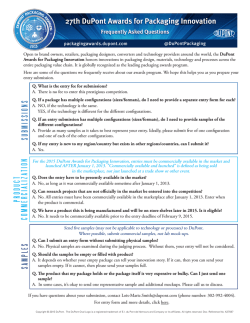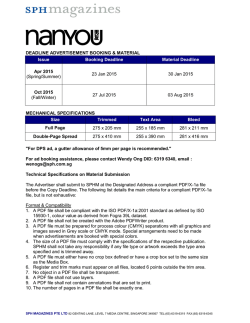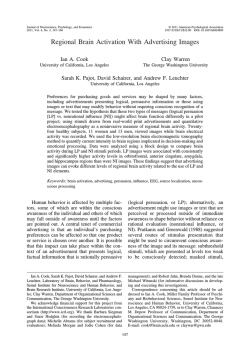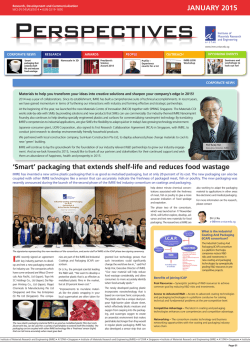
Understanding the influence from web-shop design
Understanding the influence from web-shop design on consumers’ visual attention and product evaluation Jesper Clement and Maria Kokkoli Center for Decision Neuroscience Department of Marketing, Copenhagen Business School Introduction Buying behaviour theory goes back to the start of the 50’s and over the years different models have been developed influenced by different sociological views and trends. In the age of digitalization and e-commerce these theories seem to be less useful and need revision. In the early days of the Web, research argues for a broader view on the complex decision process (Bettman et al., 1998; Hansen, 2005) and regards consumers having constructive decision processes. In the light of on-line sale additional perspectives on decision-models are still needed and recent research emphasizes the important in studying relations between human visual attention and intention to purchase (Clement, 2013). Several companies have found an additional market place on-line, whereas the appearance of the products is often very similar to the physical shop. This goes especially for pharmaceutical products, where pictures of the product package together with pictures of the pills are used as eye-catcher on-line. The market for e-health is increasing (Usher and Skinner, 2010) and distribution of consumers purchasing on-line health products looks similar to the distribution in average populations. As the on-line drug store goes across culture and national borders it also challenges marketer to make the right set-up for a web-shop. In this paper customers’ visual attention during search for drugs on-line is investigated, relating visual attention and evaluation to a particular web-design. Visual cues for getting consumers’ attention on-line While the visual stimuli on ads have been subject for several research (e.g. Pieters and Warlop, 2002) the effects of on-line visual cues in web-shops on decision-making has not been thoroughly explored. Studies on consumers’ response and trust towards e-health website find general web design considerations to be followed, which includes (1) ease of navigation; (2) content relevance; and (3) appropriate interactivity (Usher and Skinner, 2010). Graphic design elements like name, typography, frame and their visual saliency influence consumers’ preferences of the website (Brigg, 2008). The same goes for a website dealing with health and a common user judge the products on the appearance of the graphic design elements named above, where insight into visual attention and user’s gaze pattern are of great importance. Yet, the optimal way to promote health products in a web-shop seems to be less clear. Product promotion accompanied with text, pictures of pills, or emotional illustrations might be interpreted as persuaders or distracters. From literature, it is found that emotional images create greater activity in visual cortex than neutral images (Bradley et al., 2003). Therefore, in a case of drug product promoted on-line in combination with happy people or handsome faces, customers might evaluate these health products more positive. In addition consumers might assume the medicine will fight the disease better and they are going to explore the placebo phenomenon (Geers et al, 2005). The aim of the experiment described in this paper is to reveal the influential effect of attractive illustrations, such as happy people and less emotional loaded illustration like a picture of the plain pills. There is a long tradition to examine colours scientific and relate specific colours to specific human behaviour, not the least consumers’ intention to buy (Belizzi and Hite, 1992). Here they quote several older research papers, emphasizing a strong relation between emotions and colours (Schachtel, 1943), and specific colours influence on consumers’ attitudes (Gerard, 1957), and other researches argue for connections between colour and cultural (Terwogt and Hoeksma, 1995). Several research have found warm colours being associated with excited mood and positive emotions (Schaie and Heiss, 1964), extroverted activity (Aaronson, 1970), excitement (Cahoon, 1969), and visual orientation (Jaensch, 1930; Bjerstedt, 1960). Warm colours seem to be the winner in the battle of getting visual attention (Birren, 1978), (Gelasca et al., 2005). Not surprisingly have cold colours been associated with concepts of peacefulness, calmness, restfulness (Sharpe, 1974). No matter what colour hue, the affective dimension of the colour was found to make the impact on consumers’ likelihood to purchase (Belizzi and Hite, 1992). In the light of using colour especially for a packaging design, the relevance in combining colour interpretation with gender theory has been emphasized (Coursaris et al, 2008). The authors here found blue and especially cold colours in general to be related with trust, effectiveness, and satisfaction with some gender differences. Females tend to respond more positive to colours like red, pink, and yellow (Ellis and Ficet, 2001). Searching the literature for other combinations of colour and packaging, we find bright colours to be linked with expectations of low-quality products (Creusen and Schoormans, 2005), whereas other studies in the food industry shown that packaging colour is closely linked to taste. Orange colour seems to affect consumers to expect higher level of sweetness and better quality in juice products (Becker et al., 2011). Consequently, the challenging question for a marketer or a web-designer is whether the right choice of colour is to grab visual attention by choosing warm colours or to build trust through cold colours. The aim of the experiment described in this paper is to reveal the influential effect of colour on the packaging of medicines promoted in a web-shop. Investigating decision-making in on-line stores There has been a tremendous shift from the traditional neoclassical way of doing research on decision-making turning the focus on the unconscious aspect of consumer choice. The majority of decision-making theories focus on analytic procedures building on information search. Nevertheless, intuitive and emotional reactions have a strong position in consumers’ choice and consequently the impact from subliminal and emotional stimuli are not part of these models. Conventional decision models of fast and often repeated purchases like cue utilisation model (Olson and Jacoby 1972) and theory of planned behaviour (Ajzen 1991) assume that consumers know what they come for, and that they will recognise products and brands when they see them. However, purchase situations on-line are characterised by multiple competing visual stimuli, in the form of, for example, advertising or visual displays, that are continuously consciously and unconsciously stimulating consumers. In addition research in neuroscience suggest the human mind able to process subliminal information and attention can operate on or be directed towards an item that is not consciously perceived (Cohen, Cavanagh, Chun, and Nakayama, 2012). This attention might come from a top-down process – stimulated by the individual searching for a specific colour, or it might be related to a bottom-up process – stimulated by the objects physical appearance. The latter might stem the for on-line store design and the impact of such stimuli on consumer decision process is not likely to be researched through classically method techniques tools like verbal response. Only few stimuli make traces in the memory (Simons and Chabris, 1999) and verbal recall of a decision-making might be biased by intention (Valor, 2007). Research design Aiming to create an experiment able to test visual attention and cognitive evaluation of the drug product, we ran a random series of manipulated stimuli in an eye-tracker followed by an evaluation scales. First we changed the colour of the product packaging in Photoshop making exactly the same product appearing in two colours; one warm and one cold (Figure 1). Ten different product packaging were manipulated, ranging from everyday medicine such as headache pills to pills against hair loss. Figure 1 Each of these manipulated product packaging was then combined with an illustration on their left side, either a picture of handsome people, an illustration of the pills, or a nonsense illustration of e.g. birds or a house. In order to secure that no test person saw the same product twice, the stimuli of combined product packaging and illustration were divided into four series. In order to blur our intention with the experiment, we supplemented each series with ten other stimuli of health products and illustration. Each series now contained twenty stimuli/trails, which were shown in random order. We ran the experiment on a high-resolution Tobii T60 XL tracker with a 1920x1200 pixel screen resolution. Viewing distance was approximately 60 cm. and each series started with a 9-point calibration procedure. Each of the twenty stimuli/trail started with a fixed cross displayed for 2 seconds, aiming reliability in data. Each stimuli/trail was displayed for 5 seconds, followed by four questions: 1) How trustful do you believe this brand to be? 2) How effective do you consider this medicine to be? 3) How expensive do you consider this medicine to be? 4) Do you feel this medicine attractive? Each question had an ordinal scale just below going from -3 to 3. Following the eye-tracking session the participants are called to fill a questionnaire regarding demographical information and their relation with drugs. We also asked if participant was familiar or regular user of any of the products. This last question gave us the opportunity to take out data from those trails where any previous relation to the shown drug products might have influenced both visual attention and evaluation. The group of test persons consisted of 45 people from various European counties divided into 19 women and 26 men fluctuating from 20 to 33 years old. They were invited through social networks like Facebook, and the only condition among the participants was to speak and understand fluently English. They were compensated with a double ticket for a cinema show for their participation. Findings Data collection was done using Attention Tool version 4.5 (iMotions Inc., www.imotionsglobal.com) and the types of variables from the tracker were saccades (number of eye-movements), time to first fixation (milliseconds), and total fixation time (milliseconds). These variables were all specifically related to an area-of-interest (AOI). The outcomes from the evaluation scales were whole numbers on trustworthy, effectiveness, expensiveness and likeness. These data were calculated in SPSS version 19. TRUSTWORTHY A two-way ANOVA gave us a significant indication on males evaluating the medicine products more trustworthy than female (p<0,0004 and F=4,455). For both genders the trustworthiness can be increased when the drug packaging is dominated by a cold colour (p<0,03 and F=4,485). Women seem to have a more fumbling glance, having higher number of saccades than men (p<0,0000001 and F=19,106), whereas combining the product packaging with a picture of happy people make female increase their score on trust (p<0,034205and F=4.485). When combining the product packing with a nonsense illustration it decreases peoples’ trust evaluation. EFFECTIVENESS As for trust, the two-way ANOVA found significant differences among gender, and cold colours increase evaluation on effectiveness for both groups (p<0,00009 and F=19,808). Again we find female to be more unsecure by having more significant more saccades than men (p<0,000001, F=21,234). Adding illustration of pills and nonsense illustrations to the product packing lower the evaluation on effectiveness. EXPENSIVENESS In evaluating the cost of the medicine, women seem in this case to be more certain having significant less saccades than men (p<0,00001 and F=36,504). Nonsense illustrations lower the evaluation on how expensive the participants consider the product to be. We found no correlation to other independent variables in relation to anticipate price on medicine. LIKENESS We found again men to evaluate liking higher than female and for both genders cold colour on the product packaging increase the likeness (p<0,00001 and F=32,174). The evaluation of likeness is negatively influenced by illustrations of handsome people. Beside cold colours influence on the evaluation of trust, effectiveness, and liking, we found warm colours on product packaging to generate more uncertainty. We found for both genders significant more saccades when the packaging had a warm colour (p<0,000001 and F=7,452). People tend to gaze significantly longer on the illustrations (pills, text, or images of handsome people) than on the product packaging. We found no relation between colour and visual attention (time-to-first-fixation and total-fixation-time). Conclusion and discussion Visual salience is not a property solely related to the target product, but a relationship between the item and other visual element within the scene. Colour and accompanied images are crucial aspects that influence people’s interpretation of the medicine. This study gave insights into the important of choosing cold colour for medicine packaging in order to increase the interpretation of trust effectiveness and liking. The highest effect from cold colours was found on liking followed by the influence on effectiveness. This underlines the relevance in taking product packaging colour into consideration when discussing placebo effect. The results show on the hand packaging colour to have no influence on how people interpret the price of the product. Combination the product packaging with illustrations containing no relation to the product seems in best case to have limited effect and in worth case to have a negative influence on peoples evaluation. The negative interpretation of effectiveness and by that the placebo influenced by nonsense illustration, seems to be in line with how people interpret these types of illustrations, yet the negative effect on effectiveness coming from illustrations of pills is not clear, and calls for further research. It was expected that the warm colour on product packaging would attract more visual attention, but we did not found such a correlation. This might stem from the research design, where five seconds for each trail were too little in order to measure differences in gaze time. Also other parameters such as saturation and brightness could become subjects for further research. References Ajzen, I. 1991, The theory of planned behavior, Organizational behavior and human decision processes, vol. 50, no. 2, pp. 179-211. Aaronson, B., 1970, Some affective stereotypes of color. International Journal of Symbology, vol. 2, pp. 15-27. Becker L., Rompay T. J. L., Schifferstein H. N. J., Galetzka M., 2011, Tough package, strong taste: The influence of packaging design on taste impressions and product evaluations. Journal of food quality and preference, vol. 22, no. 1, pp.17-23. Bellizzi, J.A. & Hite, R.E., 1992, Environmental color, consumer feelings, and purchase likelihood. Psychology and Marketing, 9,347–363. Bettman, J.R., Luce, M.F. & Payne, J.W. 1998, Constructive consumer choice processes, Journal of Consumer Research, vol. 25, no. 3, pp. 187-217. Birren, F., 1997, The Power of Color: How It Can Reduce Fatigue, Relieve Monotony, Enhance Sexuality, and More, Secaucus, New Jersey: Carol Publishing Group. Bjerstedt, A., 1960, Warm-cool color preferences as potential personality indicators, Perceptual und Motor Skills, vol. 10, pp. 31-34. Bradley M. M., Sabatinelli D., Lang P. J., Fitzsimmons J. R., 2003, Activation of the Visual Cortex in Motivated Attention. Behavioral Neuroscience, American Psychological Association, Vol. 117, No. 2, 369–380. Briggs P. 2008, "Designing effective health websites", Perada magazine towards pervasive adaption, 1287. Cahoon, R. L., 1969, Physiological arousal and time estimation, Perceptual and Motor Skills, vol. 28, pp. 259-268. Clement, J., Kristensen, T. & Grønhaug, K. 2013, Understanding consumers' in-store visual perception: The influence of package design features on visual attention, Journal of Retailing and Consumer Services, vol. 20, no. 2, pp. 234-239. Creusen, M., and Schoormans J., 2005, The Different Roles of Product Appearance in Consumer Choice. Journal of Product Innovation Management, vol. 22 no. 1, 63. Cohen, M.A., Cavanagh, P., Chun, M.M. & Nakayama, K. 2012, The attentional requirements of consciousness, Trends in Cognitive Sciences, vol. 16, no. 8, pp. 411-417. Coursaris C. K., Swierenga S. J., Watrall E., 2008, An empirical investigation of color temperature and gender effects on web aesthetics, Journal of usability studies, vol. 3, no. 3, pp. 103-117. Ellis L., Ficek C., 2001, Color preferences according to gender and sexual orientation. Personality and Individual Differences, vol. 31, no. 8, pp. 1375–1379. Geers, A. L., Weiland, P. E., Kosbab, K., Landry, S. J., & Helfer, S. G., 2005, Goal Activation, Expectations, and the Placebo Effect. Journal Of Personality And Social Psychology, 89(2), pp. 143-159. Gelasca E., Tomasic D., Ebrahimi T., 2005, Which Colors Best Catch Your Eyes: a Subjective Study of Color Saliency. Fisrt International Workshop on Video Processing and Quality Metrics for Consumer Electronics, Scottsdale, Arizona, USA Hansen, T. 2005, "Perspectives on consumer decision making: An integrated approach", Journal of Consumer Behaviour, vol. 4, no. 6, pp. 420-437. Jaensch, E.R., 1930, Eidetic imagery, London: Kegan, Paul, Trench, and Trubner, Ltd. Olson, J.C. & Jacoby, J. 1972, "Cue Utilization in the Quality Perception Process", Proceedings of the Third Annual Conference of the Association for Consumer Research, pp. 167. Pieters, R. & Warlop, L. 2002, "Recent Developments in Visual Attention Research", Advances in Consumer Research, vol. 29, no. 1, pp. 89. Schachtel E. G. (1943). On color and affect, Psychiatry, vol. 6, pp.393-409. Schaie, K. W., & Heiss, R., 1964, Color and contrast in magazine advertising, Psychology and Marketing, vol. 3 no.2, 69- 78. Simons, D.J. & Chabris, C.F. 1999, "Gorillas in our midst: sustained inattentional blindness for dynamic events", Perception, vol. 28, pp. 1059-1074. Sharpe, D. T., 1974, The psychology of color and design. Chicago: Nelson-Hall. Terwogt M. M., Hoeksma J.B., 1995, Colors and emotions: preferences and combinations. The journal of general Psychology, 122(1), pp. 5-17. Valor, C. 2007, "The influence of information about labour abuses on consumer choice of clothes: a grounded theory approach", Journal of Marketing Management, vol. 23, no. 7, pp. 675-695. Usher W., Skinner J. (2010). Categorizing health websites: e-knowledge, e-business and eprofessional. Health Education Journal, vol. 9.
© Copyright 2026



